|
 Sharing life after death: In 2004, a grave was excavated in Cyprus that contained the skeletons, laid close to one another, of both a human and a cat. The grave is estimated to be 9,500 years old, pushing back the earliest known feline-human association significantly. Like some other domesticated animals, cats live in a mutualistic arrangement with humans. It is believed that the benefit of removing rats and mice from humans' food stores outweighed the trouble of extending the protection of a human settlement to a formerly wild animal, almost certainly for humans who had adopted a farming economy. Unlike the dog, which also hunts and kills rodents, the cat does not eat grains, fruits, or vegetables. Sharing life after death: In 2004, a grave was excavated in Cyprus that contained the skeletons, laid close to one another, of both a human and a cat. The grave is estimated to be 9,500 years old, pushing back the earliest known feline-human association significantly. Like some other domesticated animals, cats live in a mutualistic arrangement with humans. It is believed that the benefit of removing rats and mice from humans' food stores outweighed the trouble of extending the protection of a human settlement to a formerly wild animal, almost certainly for humans who had adopted a farming economy. Unlike the dog, which also hunts and kills rodents, the cat does not eat grains, fruits, or vegetables.
Herding like cats: The simile "like herding cats" refers to the seeming intractability of the ordinary house cat to training in anything, unlike dogs. Despite cohabitation in colonies, cats are lone hunters. It is no coincidence that cats are also "clean" animals; the chemistry of their saliva, expended during their frequent grooming, appears to be a natural deodorant. If 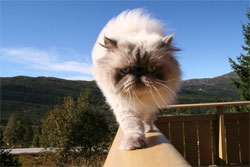 so, the function of this cleanliness is to decrease the chance a prey animal will notice the cat's presence in time. In contrast, dog's odor is an advantage in hunting, for a dog is a pack hunter; part of the pack stations itself upwind, and its odor drives prey towards the rest of the pack stationed downwind. This requires a cooperative effort, which in turn requires communications skills. No such communications skills are required of a lone hunter. It is likely this is part of the reason interacting with such an animal is problematic; cats in particular are labeled as opaque or inscrutable, as well as aloof and self-sufficient. However, cats can be very affectionate towards their human companions, especially if they imprint on them at a very young age and are treated with consistent affection. so, the function of this cleanliness is to decrease the chance a prey animal will notice the cat's presence in time. In contrast, dog's odor is an advantage in hunting, for a dog is a pack hunter; part of the pack stations itself upwind, and its odor drives prey towards the rest of the pack stationed downwind. This requires a cooperative effort, which in turn requires communications skills. No such communications skills are required of a lone hunter. It is likely this is part of the reason interacting with such an animal is problematic; cats in particular are labeled as opaque or inscrutable, as well as aloof and self-sufficient. However, cats can be very affectionate towards their human companions, especially if they imprint on them at a very young age and are treated with consistent affection.
Spoiled Cats: Human attitudes toward cats vary widely. Some people keep cats for companionship as pets. Others go to great lengths to pamper their cats, sometimes treating them as if they were children. When a cat bonds with its human guardian, the cat may, at 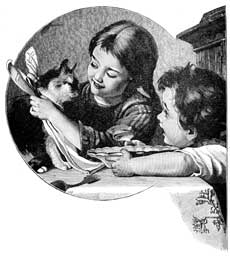 times, display behaviors similar to that of a human. Such behavior may include a trip
to the litter box before bedtime or times, display behaviors similar to that of a human. Such behavior may include a trip
to the litter box before bedtime or
snuggling up close to its companion
in bed or on the sofa. Other such
behavior includes mimicking sounds
of the owner or using certain sounds
the cat picks up from the human;
sounds representing specific needs of
the cat, which the owner would recognize, such as a specific tone of meow along with eye contact that may represent "I'm hungry." The cat may also be capable of learning to communicate with the human using non-spoken language or body language such as rubbing for affection (confirmation), facial expressions and making eye contact with the owner if something needs to be addressed (e.g., finding a bug crawling on the floor for the owner to get rid of). Some owners like to train their cat to perform "tricks" commonly exhibited by dogs such as jumping, though this is more rare than with dogs.
Handkerchief, please: Allergies to cat dander are one of the most common reasons people cite for disliking cats. However, in some instances, humans find the rewards of cat companionship outweigh the discomfort and problems associated with these allergies. Many choose to cope with cat allergies by taking prescription allergy medicine and bathing their cats frequently, since weekly bathing will eliminate about 90% of the cat dander present in the environment. Recent studies have indicated that humans who are exposed to cats or dogs within the first year of their lives develop few animal allergies, while most adults who are allergic to animals did not have a cat or a dog as a pet in childhood.
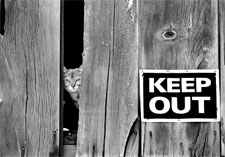 City Life: In urban areas, some people find feral
and free-roaming pet cats annoying and intrusive. Unaltered City Life: In urban areas, some people find feral
and free-roaming pet cats annoying and intrusive. Unaltered
animals can
engage in persistent nighttime calling (termed caterwauling) and defecation or "marking" of private property. Indoor confinement of pets and TNR (trap, neuter, return) programs for feral cats can help; some people also use cat deterrents to discourage cats from entering their property.
Take me home, country road: In rural areas, farms often have dozens of semi-feral cats. Hunting in the barns and the fields, they kill and eat rodents that would otherwise spoil large parts of the grain crop. Many pet cats successfully hunt and kill rabbits, rodents, birds, lizards, frogs, fish, and large insects by instinct, but might not eat their prey. They may even present their kills, dead or maimed, to their humans, perhaps expecting them to praise or reward them, or possibly even to complete the kill and eat the mouse. Others speculate that the behavior is a part of the odd relationship between human and cat, in which the cat is sometimes a 'kitten' (playing, being picked up and carried) and sometimes an adult (teaching these very large and peculiar kittens how to hunt by demonstrating what the point of it all is).
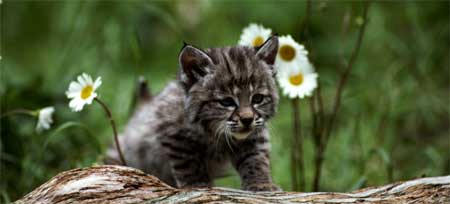
Social Butterflies: Despite its reputation as a solitary animal, the domestic cat is social enough to form colonies, but does not attack in groups as lions do. Some breeds like bengal, ocicat and manx are very social, but are exceptions. While each cat holds a distinct territory (sexually active males having the largest territories, and neutered cats having the smallest), there are "neutral" areas where cats watch and greet one another without territorial conflicts.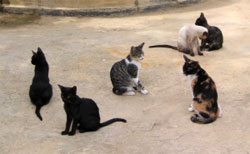 Outside these neutral areas, territory holders usually aggressively chase away stranger cats, at first by staring, hissing, and growling, and if that does not work, by short but noisy and violent attacks. Outside these neutral areas, territory holders usually aggressively chase away stranger cats, at first by staring, hissing, and growling, and if that does not work, by short but noisy and violent attacks.
Street Fighting Cats: Fighting cats make themselves appear more impressive and threatening by raising their fur and arching their backs, thus increasing their visual size. Cats also behave this way while playing. Attacks usually comprise powerful slaps to the face and body with the forepaws as well as bites, but serious damage is rare; usually the loser runs away with little more than a few scratches to the face, and perhaps the ears. Normally, serious negative effects will be limited to possible infections of the scratches and bites; though these have been known to sometimes kill cats if untreated. In addition, such fighting is believed to be the primary route of transmission of feline immunodeficiency virus (FIV). Sexually active males will usually be in many fights during their lives, and often have decidedly battered faces with obvious scars and cuts to the ears and nose. Not only will males fight; females will also fight over territory or to defend their kittens, and even neutered cats will defend their (smaller) territories aggressively.
Domestic cats have been known to protect their territories (dwellings) even to the extent of attacking human intruders, although less often and less reliably than dogs.
All text is available under the terms
of the GNU Free Documentation License
|
